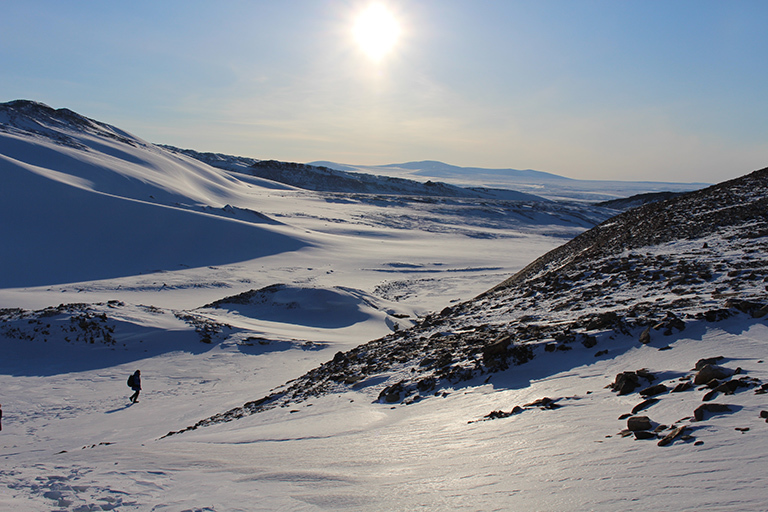Ask NASA Climate | June 5, 2017, 09:31 PDT
Sun and sky, snow and ice
Reflections at the top of the world

Hiking up to Greenland’s ice sheet, the sun remains low on the horizon even during midday.
It was 11:30 in the morning and GLISTIN-A instrument engineer Ron Muellerschoen and I were in northern Greenland at the Thule Air Base pier looking over the frozen Wolstenholme Bay. We’d been talking about the time Ron was wearing shorts here during the summer, but today it was the typical -22 Fahrenheit (-30 Celsius.) And even though over the past week we’d somehow gotten used to the cold and I was wearing a big parka, my legs were starting to get cold after walking for an hour. So we decided to head back.
As we turned around to go, I was struck in the face by the sun’s rays reflecting off the ice-covered ground. The brightness was astounding. And in that instant the meaning of “albedo” was seared into my brain in a way that went beyond reading about the science or looking at illustrations and animations.
There was something special about the experience of having the rays of the sun, which was sitting low in the high latitude sky, hit the ice surface at that extremely low angle and reflect off into my eyes.
Albedo is a measure of how reflective a surface is, how much light energy bounces off and reflects away and how much light energy gets absorbed. (Think hot asphalt on a sunny day. Black asphalt has a low albedo and absorbs light energy, while the brightest white has the highest albedo and reflects the light.)
I stood for a moment, looking at the ground — a hard, dry, crusty mixture of ice and snow that made an exceptionally satisfying crunch crunch noise as our boots marched through it — and tried to figure out the color: 50 shades of white. I settled on white/light blue/silvery sparkle. Due to the low angle of the sun, the tiniest rough edge the size and shape of a pebble on the ground’s textured surface left a long, dark shadow.
No matter where we were or how we stood or what time of day, all day, every day, there were always long shadows — crazy long shadows. At 78 degrees north latitude, a full 12 degrees above the Arctic Circle, the sun will never be overhead. Never. I know that seems unbelievable, but even during the summer solstice, when Earth’s North Pole is tilted toward the sun, or during the four summer months of 24-hour daylight, the sun is always low, low, low at this latitude.
Low on the horizon
In that moment, I also understood another science question that had been bothering me. I’d been wondering why the meter-thick sea ice hadn’t yet begun to melt. Even though it was the end of March, even though the equinox had passed, the sun was out and the days were getting longer. In fact, up here the days were getting much longer, very quickly. On March 23, just three days after the equinox, we were already having 14-hour days with sunsets lasting past 9 p.m. That’s because in these high latitudes, the day length can increase by as much as 40 minutes per day. And by mid-April, just a few weeks after spring equinox, there will be 24 hours of daylight and the sun won’t set again until September.
By mid-April the meter-thick layer of frozen seawater that covers the sea surface and fills the fjords will completely melt and expose the dark blue ocean underneath. But today, even in this brilliant sunshine, even on this day of 14-hour sunlight, the ocean was still completely frozen over.
But “Why?” I’d been wondering. Why, with all this extra sunshine, was the sea surface still so frozen? And why did that hard, dry, crusty mixture of ice and snow still remain on the ground?
In that instant, as the glint of the sunlight reflecting off the icy ground hit my face, I knew exactly why. It was the extraordinarily low angle of the sunlight that bounced right off the stunning bright whiteness of the ice. The sunlight was not absorbed by the ice and snow and instead was reflected away. It wouldn’t be until another month or so that the sun would get a little higher in the sky. And although the sun would never be directly overhead up here, it would be high enough to begin melting the ice.
No matter how much a person studies Greenland, or the northern latitudes, or albedo, or Earth in general, going into the field to experience those things can change your entire understanding of the world and how it works. I stood there for a moment, just allowing the high-latitude sun’s cold rays to glance off the snowy ice and shine straight into my face.
NASA’s Oceans Melting Greenland (OMG) team is here in Greenland; here to find out specifically how much ice the island is losing due to warmer ocean waters around the coastline. There is almost no ocean data in remote places like this, but OMG is busy working to change that, studying the complex ocean processes that affect Greenland's coastline because gathering data is critical to understanding Earth’s complex climate. This information will help us understand the amount of sea level rise we're going to have around the world.
Thank you for reading,
Laura
